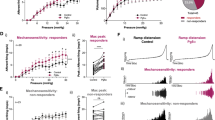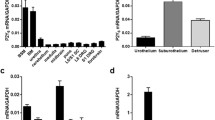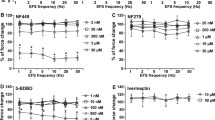Abstract
The aim of this study was to demonstrate the presence of 5-HT3 receptors in the mouse bladder and to determine their location. Bladder strips from female mice were set up in gassed Krebs–Henseleit solution at 37°C and contractions recorded in response to electrical field stimulation (8 Hz, 60 V, 0.5-ms pulse duration) applied for 2 s every 50 s. The potentiating effects of 5-hydroxytryptamine (5-HT) were recorded (in the presence of 1-μM methysergide and 1-μM GR125487 to isolate the 5-HT3 receptor response), and contractions were expressed as a percentage of the response to 0.1-M KCl. Responses to (5-HT) were also obtained in the presence of the 5-HT3 receptor antagonist, ondansetron. RT-PCR was used to detect the expression of the 5-HT3A and 5-HT3B subunit transcripts of the mouse 5-HT3 receptor. 5-HT and 5-HT3 receptor agonists caused concentration-dependent increases in the force of neurogenic contractions without affecting the baseline tone. The rank order of potency was: meta-chloro-phenylbiguanide (m-CPB) = 5-HT > 2-methyl-5-HT (2m5-HT) = 1-phenylbiguanide (1-PBG). The respective pEC50 values were: 6.42 ± 0.2 = 5.95 ± 0.19 > 5.35 ± 0.12 = 5.14 ± 0.13. m-CPB acted as a full agonist (E max = 40.65 ± 3.81% KCl), but both 2m5-HT and 1-PBG acted as lower potency partial agonists. Ondansetron (30, 100, 300 nM) caused concentration-related rightward displacements to the concentration–effect curve to 5-HT. Nonlinear regression analysis of the effect of the ondansetron concentrations on the pEC50 values produced a pKB value of 8.29 ± 0.22. Desensitization of sensory nerves to the contractile effect of capsaicin (10 μM for 60 min) did not alter the ability of 5-HT to potentiate neurogenic contractions. 5-HT (3 μM) inhibited contractions induced by direct muscle stimulation (lignocaine, 300 μM and 10-ms pulse width). m-CPB also caused the same effect with a pIC50 of 6.62 ± 0.10 and an E max of 48.03 ± 2.25%. The concentration–response curve to m-CPB was shifted rightwards by ondansetron (1 μM) giving an apparent pKB value of 8.15 ± 0.33. mRNA for both the 5-HT3A and 5-HT3B receptor subunits was detected in the detrusor as well as the mucosa with a greater relative expression of the 5-HT3A subunit in both layers. This study demonstrates that 5-HT mediates enhanced neurogenic contractions of the mouse bladder muscle by an action at 5-HT3 receptors located prejunctionally on nonsensory nerve elements. Additionally, an inhibitory postjunctional population of the 5-HT3 receptor was identified. The presence of the 5-HT3 receptor was confirmed by the expression of both 5-HT3A and 5-HT3B receptor subunits of the 5-HT3 receptor.






Similar content being viewed by others
References
Acevedo GC, Contreras E (1985) Possible involvement of adenine nucleotides in the neurotransmission of the mouse urinary bladder. Comp Biochem Physiol 82C:357–361
Alexander SP, Mathie A, Peters, JA (2004) Guide to receptors and channels, 1st edition. Br J Pharmacol 141(Suppl 1):S1–S126
Arunlakshana O, Schild HO (1959) Some quantitative uses of drug antagonists. Br J Pharmacol 14:48–58
Barras M, Van der Graaf PH, Angel I (1996) Characterisation of the 5-HT receptor potentiating neurotransmission in rabbit bladder. Eur J Pharmacol 318:425–428
Bayliss M, Wu C, Newgreen D, Mundy AR, Fry CH (1999) J Urol 162:1833–1839
Bernoussi A, Rioux F (1989) Effects of capsaicin desensitization on the stimulatory effect of kinins, prostaglandins, biogenic amines and various drugs in guinea-pig isolated atria. Br J Pharmacol 96:563–572
Bhattacharya A, Hong Dang, Zhu Q-M, Schnegelsberg B, Rozengurt N, Cain G, Prantil R, Vorp DA, Guy N, Julius D, Ford APDW, Lester HA, Debra Cockayne DA (2004) Uropathic observations in mice expressing a constitutively active point mutation in the 5-HT3A receptor subunit. J Neurosci 24:5537–5548
Bill DJ, Coleman J, Hallett I, Middlefell VC, Rhodes KF, Fletcher A (1995) The enantiomers of zacopride: an intra-species comparison of their potencies in functional and anxiolytic models. Br J Pharmacol 115:775–780
Chapple CR, Radley SC, Martin SW, Sellers DJ, Chess-Williams, R (2004) Serotonin-induced potentiation of cholinergic responses to electrical field stimulation in normal and neurogenic overactive human detrusor muscle. BJU Int 93:599–604
Chetty N, Irving HR, Coupar IM (2006) Activation of 5-HT3 receptors in the rat and mouse intestinal tract: a comparative study. Br J Pharmacol 148:1012–1021
Cornelissen LL, Brooks DP, Wibberley A (2005) Female, but not male, serotonin reuptake transporter (5-HTT) knockout mice exhibit bladder instability. Auton Neurosci 122:107–110
D’Agostino G, Condino AM, Gallinari P, Franceschetti GP, Tonini M (2006) J Pharmacol Exp Ther 316:129–135
Davies PA, Pistis M, Hanna MC, Peters JA, Lambert JJ, Hales TG, Kirkness EF (1999) The 5-HT3B subunit is a major determinant of serotonin-receptor function. Nature 397:359–363
Gale JD, Grossman CJ, Darton J, Bunce KT, White-head JWF, Knight J, Parkhouse TJ, Oxford AW, Humphrey PPA (1994) GR125487: A selective and high affnity 5-HT4 receptor antagonist. Br J Pharmacol 113:120P
Giordano J, Rogers L (1989) Peripherally administered serotonin 5-HT3 receptor antagonists reduce inflammatory pain in rats. Eur J Pharmacol 170:83–86
Hapfelmeier G, Tredt C, Haseneder R, Zieglgansberger W, Eisensamer B, Rupprecht, R, Rammes G (2003) Co-expression of the 5-HT3B serotonin receptor subunit alters the biophysics of the 5-HT3 receptor. Biophys J 84:1720–1733
Holt SE, Cooper, M, Wyllie, JH (1986) On the nature of the receptor mediating the action of 5-hydroxytryptamine in potentiating responses of the mouse urinary bladder strip to electrical stimulation. Naunyn Schmiedebergs Arch Pharmacol 334:333–340
Hoyer D, Clarke DE, Fozard JR, Hartig PR, Martin GR, Mylecharane EJ, Saxena, PR, Humphrey PPA (1994) International union of pharmacology classification of receptors for 5-Hydroxytryptamine (Serotonin). Pharmacol Rev 46:157–203
Klarshov P, Horby-Petersen J (1986) Influence of serotonin on lower urinary tract smooth muscle in vitro. Br J Urol 58:507–513
Lew MJ, Angus JA (1995) Analysis of competitive agonist–antagonist interactions by nonlinear regression. Trends Pharmacol Sci 16:328–337
Maggi CA (1991) The pharmacology of the efferent function of sensory nerves. J Auton Pharmacol 11:173–208
Messori E, Rizzi CA, Candura SM, Lucchelli A, Balestra B, Tonini M (1995) 5-Hydroxytryptamine receptors that facilitate excitatory neuromuscular transmission in the guinea-pig isolated detrusor muscle. Br J Pharmacol 115:677–683
Nieto JE, Snyder JR, Kollias-Baker C, Stanley S (2000) In vitro effects of 5-hydroxytryptamine and cisapride on the circular smooth muscle of the jejunum of horses. Am J Vet Res 61:1561–1565
O’Reilly BA, Kosaka AH, Knight GF, Chang TK, Ford APDW, Rymer JM, Popert R, Burnstock G, McMahon SB (2002) P2X receptors and their role in female idiopathic detrusor instability.J Urol 167:157–164
Palea S, Artibani W, Ostardo E, Trist DG, Pietra C (1993) Evidence for purinergic neurotransmission in human urinary bladder affected by interstitial cystitis. J Urol 150:2007–2012
Seong YH, Baba A, Matsuda T, Iwata H (1990) 5-Hydroxytryptamine modulation of electrically induced twitch responses of mouse vas deferens: involvement of multiple 5-hydroxytryptamine receptors. J Pharmacol Exp Ther 254:1012–1016
Sepulveda MI, Lummis SC, Martin IL (1991) the agonist properties of m-chlorophenylbiguanide and 2-methyl-5-hydroxytryptamine on 5-HT3 receptors in N1e-115 neuroblastoma cells. Br J Pharmacol 104:536–550
Tuladhar BR, Womack, MD, Naylor RJ (2000) Pharmacological characterization of the 5-HT receptor-mediated contraction in the mouse isolated ileum. Br J Pharmacol 131:1716–1722
Vial C, Evans RJ (2000) P2X receptor expression in mouse urinary bladder and the requirement of P2X1 receptors for functional P2X receptor responses in the mouse urinary bladder smooth muscle. Br J Pharmacol 131:1489–1495
Waikar MV, Ford, APDW, Clarke DE (1994) Evidence for an inhibitory 5-HT4 receptor in urinary bladder of Rhesus and Cynomolgus monkeys. Br J Pharmacol 111:213–218
Wyllie JH, Cooper M, Please NM (1983) Effects of 5-hydroxytryptamine on a new pharmacological preparation—the mouse bladder strip. Br J Pharmacol 78:85P
Xu L, Yu B-P, Chen J-G, Luo H-S (2007) Mechanisms mediating serotonin-induced contraction of colonic myocytes. Clin Exp Pharmacol Physiol 34:120–128
Yakel JL, Jackson MB (1988) 5-HT3 receptors mediaterapid responses in cultured hippocampus and a cultured cell line. Neuron 1:615–621
Yoshida A, S.-Yamashita Y, Kaibara M, Taniyama K, Tanaka N (2002) 5-Hydroxytryptamine receptors, especially the 5-HT4 receptor, in guinea pig urinary bladder. Jpn J Pharmacol 89:349–355
Yoshida M, Miyamae K, Iwashita H, Otani M, Inadome A (2004) Management of detrusor dysfunction in the elderly: changes in acetylcholine and adenosine triphosphate release during aging. Urology 63:17–23
Acknowledgements
This work was supported by a Monash University, Faculty of Pharmacy Small Grants Scheme. We thank Miss Michelle Lam, Miss Rosie Adsley and Mr. Jun Liu for assistance in the laboratory.
Author information
Authors and Affiliations
Corresponding author
Rights and permissions
About this article
Cite this article
Chetty, N., Coupar, I.M., Chess-Williams, R. et al. Demonstration of 5-HT3 receptor function and expression in the mouse bladder. Naunyn-Schmied Arch Pharmacol 375, 359–368 (2007). https://doi.org/10.1007/s00210-007-0173-7
Received:
Accepted:
Published:
Issue Date:
DOI: https://doi.org/10.1007/s00210-007-0173-7




